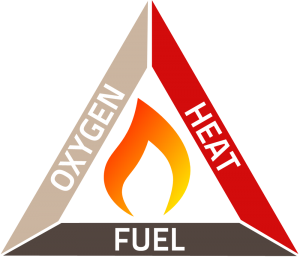Simple Steps for Training Your Staff in Fire Safety

Within any commercial setting, it’s a legal requirement for certain members of staff to be trained in fire safety procedures – becoming your environment’s designated fire wardens as a result. The person trained should have a clear understanding of the overall duties and responsibilities they have as a fire warden. This will include: what action they should take on the discovery of a fire, know the difference between different fire classes, which extinguisher to use for which fire and what the evacuation procedure is.
Understanding the Fire Triangle
A fire needs 3 elements in order for it to ignite – oxygen, fuel and heat – and a fire can be extinguished by removing one of these elements. For instance, covering a fire with a fire blanket removes the oxygen supply, therefore putting the fire out.
Discovering a fire (alarm and assembly points)
On discovering a fire, the first thing you should do is raise the fire alarm so everybody on the premises is aware there is a fire in the building. You should then ensure everyone safely exits the building and gathers at the appropriate assembly point.
Types of fires
Being a fire warden also entails having a basic understanding of the types of fires there are:
1) Class A fires involve solid materials such as wood, paper, rubber, plastic and cloth.
2) Class B fires involve flammable or combustible liquids, such as petrol, oil and paint.
3) Class C fires involve flammable gases, such as propane, butane and methane.
4) Class D fires involve flammable metals, such as potassium, aluminium and titanium.
5) Class F fires involve cooking oils and fats.
Types of extinguishing agents
1) Water (Red): Suitable for wood, fabric and paper.
2) Foam (Cream) : Suitable for flammable liquids, wood and paper.
3) Powder (Blue): Suitable for flammable liquids, gas, electrical hazards, oil and chemicals.
4) CO2 (Black): Suitable for flammable liquids and electricals.
5) Wet chemical (Yellow) : Suitable for cooking fat and oils.
Identification of which fire extinguisher to use for which fire
1) Water: Ideal for class A fires and office, shop or warehouse environments.
2) Foam: Use on class A or B fires on electrical or material based fires.
3) CO2: Perfect for Class B fires like those caused by flammable liquids or electrical appliances.
4) Wet Chemical: Ideal for kitchen related fires with cooking oils and fats involved.
How to use a fire extinguisher
1) Pull the pin out.
2) Aim the nozzle at the base of the fire.
3) Squeeze the lever slowly.
4) Keep at a distance and sweep the nozzle from side to side, moving closer as the flames decrease un till the fire is completely out.
People with disabilities
The Disability Equality Duty highlights that disabled people should not be discriminated against under any circumstance. Therefore, they should still be given an evacuation plan despite any differences in mobility. As such, the fire warden should be aware of those who may need extra assistance when evacuating and allow extra time for this so they are not exposed to any discrimination.
These steps outline some simple stages to training your staff in fire safety; however official fire warden training is required in order to guarantee a legitimate qualified fire warden will be on hand in the case of an emergency. The courses are available on-site or off-site, dependent on location, and the names of those who attended the course should be kept in a log book. It’s also recommended that you go on a refresher training course a year later to remind yourself of the procedures to ensure absolute safety to your fellow staff members.
If you need fire warden training or basic fire training for all your staff, Scutum London provides local courses run by experienced industry professionals. Comprising both practical and theoretical elements, our courses can give your team the confidence to respond positively in an emergency situation.
Get in touch with us now to find out more or to book fire safety training for your business.
Request a Callback
Just fill in your details below and we'll get back to you as soon as we can!

About Scutum London
Scutum London is a leading expert in fire safety and security solutions for businesses and organisations located across South East England, including London and Surrey.
From fire alarms, fire extinguishers and fire risk assessments to access control, CCTV and intruder alarm systems – and a lot more besides – we offer a comprehensive range of products and services designed to keep you, your business and your staff and visitors safe.
With decades of industry experience to call on, we’re proud to hold accreditations from leading trade associations and bodies such as British Approvals for Fire Equipment (BAFE), the British Fire Consortium, the Fire Industry Association (FIA) and Security Systems and Alarms Inspection Board (SSAIB).
If you’d like to find out more about Scutum London, get in touch with our friendly team or explore our products and services on our site.

